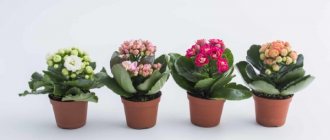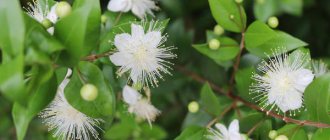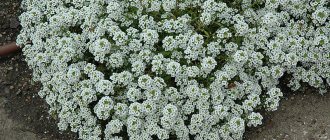Orchids have firmly entered our lives. The stores sell a varied assortment of these beauties to suit every taste and budget. Every florist tries to get his hands on an overseas whim, most often more than one specimen. Some get so carried away that they become professional orchimaniacs. They collect different varieties, propagate them and save dying plants, which are sold at a discount. From the article you will learn about orchids in winter: how to care for the flower, how to water it and what conditions to create for healthy growth.
What hybrids to grow 2. How often to water an orchid in winter 3. Humidity in the room 4. What should be the lighting 5. Temperature in winter 6. Ventilate the room 7. How to feed the plants 8. Is it possible to replant an orchid in winter
Photo: Every florist tries to get his hands on an overseas whim.
Orchid hybrids for the home
There are a large number of varieties of orchids. Every year, breeders develop new varieties with a more sophisticated flower shape and aroma. The orchid is a rather capricious flower. In order for it to bloom profusely and please the eye for many years, you need to learn how to properly care for it.
Phalaenopsis hybrids are most often sold in stores. These hybrids do not require particularly complex care and are suitable for both a novice gardener and a person who is not interested in growing flowers due to lack of time.
Phalaenopsis hybrids require approximately the same conditions of maintenance and care throughout the year.
Below we will talk about caring for hybrid varieties of orchids, which were bred in special greenhouses and intended for home growing. Natural species require slightly different conditions for successful wintering. And in everyday life they are found less often - only among avid collectors.
Photo: Phalaenopsis hybrids are most often sold in stores.
Particular attention should be paid to the winter period in her life, because caring for an orchid at home in winter at this time of year is significantly different from caring for it in the warm period. This is what we will talk about in this article.
Types of hybrid orchids intended for growing at home
Phalaenopsis - butterfly orchid
One of the most common orchids in our homes. A huge number of shades of flowers have been developed. Easy to care and maintain. It is best to place a flower pot on southern or western windows.
Photo: Phalaenopsis - butterfly orchid.
Dendrobium
A beautiful, fragrant plant, which is also easy to buy in any store in our country. The most common are Dendrobium nobile and Dendrobium phalaenopsis. They are similar in appearance, but require different care.
Photo: Dendrobium.
Wanda
Among gardeners, this orchid is considered the most beautiful. Very bright appearance. Grows with a bare root system. Also not a rare guest in the collections of Orhimans.
Photo: Wanda.
Cattleya
It has large, showy, fragrant flowers. The flowers come in a variety of shades - from white to purple. Quite a whimsical plant to which you need to find an approach.
Photo: Cattleya.
Paphioledilum - Lady's slipper
It is not fussy and can grow on any windowsill. A beautiful flower with a variety of colors.
Photo: Paphioledilum - Lady's slipper.
With the onset of cold weather, many varieties of orchids go into hibernation. Their growth slows down, flowering and root development stop.
The following varieties of orchids behave this way: Calantha, Tunia, Pleione, several species of Dendrobium and Cattleya.
Cattleya stops growing in winter and needs only humidified air.
Caring for orchids without a pronounced dormancy state
Despite the fact that the flowers from the presented group are similar to each other, caring for them at home will be slightly different.
Phalaenopsis
First of all, proper care involves bright lighting. In winter, it is necessary to turn on a fluorescent lamp. The air temperature in the room should not be lower than +12 °C. The flower should be watered only when the substrate has dried well. The manipulation should be performed by immersing the flowerpot with the plant in a basin of warm water.
In summer, phalaenopsis is sprayed, and in winter, only the area around the flower is sprayed. No fertilizing is applied in winter.
Paphiopedilum
This orchid needs the same watering at any time of the year. Considering that the flower throws out its peduncles in winter, it is imperative to turn on a fluorescent lamp. The light should be bright, but diffused. Temperature readings should not exceed + 18 °C, but also fall below +10 °C. It is important to ensure that water does not fall on the stem during watering.
Wanda
The Vanda orchid is a heat-loving flower, so the minimum temperature cannot be lower than +18 °C. The soil must be kept constantly moist. Not only the main roots need watering, but also the aerial ones, which should be sprayed regularly. The winter sun is not enough for the flower, so do not forget about the lighting.
Miltonia
Miltonia also cannot grow in cold conditions. True, she needs to find shaded habitats. During the daytime, it is good if the thermometer stays at +20..+25 °C. At night this figure can be lower and even be +15 °C. This type of orchid does not like sudden changes in temperature and drafts. You can forget about fertilizing for the winter. Watering should be reduced and manipulation should be carried out only after the substrate has dried.
How to water an orchid in winter
Proper watering of orchids in winter is perhaps the most important condition in caring for an orchid.
At the beginning of winter, we begin to gradually reduce the frequency of watering and the volume of water. As a rule, plant growth slows down in winter, even in those varieties that do not have a pronounced dormant period. The previous volume of water simply will not be absorbed by the roots. With excess moisture, unpleasant putrefactive processes and even the death of the plant can begin.
In winter, we water once every one and a half to 2 weeks.
Water for irrigation should be settled and at room temperature. Snow water is ideal.
Photo: A transparent pot helps determine whether it’s time to water or whether it’s too early.
| Advice. To determine whether you are doing everything correctly, monitor the moisture content of the substrate and the color of the roots. The substrate should not dry out completely, but water should not accumulate in the pan. |
A transparent pot helps determine whether it’s time to water or whether it’s too early. The roots are visible through its walls, and by their color and condition it is quite easy to understand what the plant needs at the moment.
Condensation on the inside drains of the pot indicates that there is no need to water.
Healthy roots should be succulent, green in color, with patches of dark lilac shades in places. If the roots are not juicy, dry or grayish-silver in color, then you need to water the plant.
You need to water the orchid not as usual, from the top, but by immersing the pot in water for a while. During this time, the roots are saturated with moisture.
Beginner orchimaniacs often make mistakes when caring for the plant after watering. They rush and remove the plant from the water when the roots are not yet completely saturated with water. They do not allow the water to completely drain from the roots and rush to put the pot in place.
Photo: Healthy roots should be succulent and green.
Often the flower stands on the windowsill, and the temperature near the window is always lower than in the room. And so, we place such a flower near the window, it continues to actively absorb the moisture it lacks, and the water temperature is rapidly decreasing. As a result, the roots of the plant receive a dose of hypothermia. Hypothermia reduces the plant's immunity and provokes the appearance of fungal diseases and putrefactive processes.
To prevent this from happening, it is not necessary to remove the pot from the windowsill.
| Advice. It is necessary to create a layer of thermal insulation between the pot and the window sill. Lay a thick layer of polystyrene foam or other material that will absorb the cold from the windowsill. And the plant itself must be placed in a pot with additional depth into which excess water will drain. |
The plant needs such a pot all year round. Therefore, when buying an orchid, immediately purchase a special pot for orchids. With large drainage holes and a high, special bottom. This is an important point that you need to know and avoid a negative scenario.
Also, all orchids love watering through a warm shower, as they are tropical natives. But even here in winter there is a peculiarity in care.
Take a warm shower in the evening and leave the orchids in the bath overnight. There they will be well saturated with moisture and dry properly until the morning. In the bathroom, as a rule, it is always warmer than in other rooms and the humidity is always higher, especially after water procedures. There, conditions are formed that are as close as possible to the natural ones in which orchids grow in nature.
Your orchids will be very grateful to you for such care and will not keep you waiting long for luxurious flowering. After such a shower, you need to remove the accumulated excess water at the base of the plant by blotting it with a paper napkin.
Photo: Orchids love watering through a warm shower.
If your water is hard and contains a lot of calcium, then after the drops dry, unpleasant marks may appear on the leaves. To avoid this, wipe the leaves before you go to bed. No need to wipe dry, just lightly to remove large drops.
| Advice. The lower the room temperature, the less often you need to water. |
Flower care depending on classes
All orchids are different, what suits one may not suit another, so they need to be divided into classes and considered each separately.
These classes are as follows:
- Phalaenopsis without a pronounced dormant state.
- Orchids with pronounced dormant periods.
- Phalaenopsis with faint periods of rest.
All these orchids require special care.
Phalaenopsis without a pronounced dormant state
Flowers that belong to this category require stable care throughout the year. We are talking about lighting, temperature, watering and humidity. True, in winter there are still some nuances, which will be discussed below. This category includes the following popular orchids: paphiopedilums (slippers), phalaenopsis, miltonia.
Phalaenopsis with mild periods of rest
Such flowers do not go into hibernation. However, caring for them in winter is somewhat different than in summer. For example, fertilizing and watering are reduced. These orchids include: oncidiums, cattleya orchids, dendrobiums and laelias.
Orchids with pronounced dormant periods
Such orchids require special care with the substrate completely dry. In winter, species that belong to the presented class are not watered, the flower loses its leaves, and shoots can only be observed in spring. We are talking about tunia, calanthus, playone and several types of dendrobiums.
Air humidity
Orchids love high humidity. In winter, after turning on the heating, the air in the room becomes dry. Dry air promotes the appearance of spider mites. Our task is to create ideal air humidity around the whims in winter. To do this, you can use a humidifier, which will create favorable conditions for both us and the plants.
There are simpler options:
- Place a saucer of water near the pot
- Spray the air around the plant 2 times a day
It is not recommended to spray the leaves and flowers of orchids. Drops of moisture will accumulate near the growth point, and there is the orchid’s weak point. Excess moisture quickly provokes rotting at the base. If the process is started, you will have to say goodbye to the orchid.
Photo: Spray the air around the plant 2 times a day.
| Important. Be very attentive to this place on the orchid, especially in winter after watering and a warm shower. Always shake off moisture from the growing point and dry with extreme care. |
- You can buy transparent deep trays, pour a layer of expanded clay into them, fill them with water, lay a grate on top and place a pot with a plant on the grate. If your orchids do not have enough air humidity, the leaves begin to turn yellow and wither. The roots stop growing altogether.
- Get an indoor fountain
Transfer
The dormant period is not the best time to transplant an orchid. There are several reasons for this:
- At this time, the plant rests and does not produce new shoots, but replanting forces it to take root in another pot. This leads to a disruption in the biological rhythm of the plant and reduces the number of inflorescences and the duration of flowering in the future.
- At this time, it is difficult for the orchid to adapt to a new place, as its growth slows down.
Even if an orchid does not have a resting phase, it can bloom in winter, which is typical for Phalaenopsis. When flowering, you should also not replant the plant. Otherwise, the inflorescences may be dropped, and the duration and abundance of subsequent blooms will decrease.
Replanting in winter is possible only if there is a threat of plant death or if there is a danger of infection of other flowers. Such cases include damage to the orchid or soil by diseases, pests, and root rot.
Replanting is carried out in the standard way - watering is stopped 2 days before, then the plant is moved to a new pot. After replanting, special attention should be paid to adequate lighting. Also, the flower needs root feeding; spraying in winter for the purpose of feeding is not carried out.
In other cases, it is better to wait until spring, when the flower begins to grow green mass and form new root shoots.
Lighting for orchids in winter
In winter, daylight hours become shorter; orchids often do not have enough natural light for normal wintering. Therefore, place pots on southern windows. And if this is not possible, take care of installing an additional light source.
From mid-October, orchids already need additional lighting. It is advisable to purchase a special phytolamp. But you can also use a regular lamp with a fluorescent bulb of about 60 watts. Light can be either warm or cold. An additional light source should be placed no further than 20–40 cm from the plant.
Photo: It is advisable to purchase a special phytolamp.
If the plant does not have enough light, it will not be able to set flower buds. With a lack of light, the leaves become stretched and acquire a dull and not very beautiful shade.
The ideal daylight hours for an orchid are from 8 am to 8 pm. Try to create such conditions, and the plant will always have a beautiful color and full of vigor.
Problems and difficulties
When growing an orchid at home, a gardener may encounter the following problems:
- Pests . The most common problem. To prevent the appearance of insects, it is necessary to do timely prevention, which consists of frequent wiping of leaves (up to 5 times a day) and timely replanting.
- The plant does not bloom . This problem often appears in the fall. In order for an orchid to bloom, it needs bright and diffused light, the application of fertilizers containing potassium and phosphorus, and a temperature that will differ between day and night.
- Poor lighting can cause the leaves to become small and limp, and the orchid will stop throwing out flower stalks. Experienced flower growers recommend purchasing a phytolamp and turning it on during short daylight hours. This will help the flower remain in its usual conditions.
Temperature for orchids in winter
The most optimal daytime temperature for orchids is considered to be +21… +24 degrees. At night it should drop slightly, but not below + 15 degrees. Temperature changes of 5-7 degrees are closest to natural. They stimulate the plant to lay flower buds.
Photo: Temperature changes of 5-7 degrees stimulate the plant to bud.
This is exactly what happens in my house. And now my phalaenopsis orchid stands with small buds.
Therefore, if you want your plant to bloom, do not create greenhouse conditions for it in winter. You can safely open the window at night and thereby lower the night temperature in the room. The plant will quickly respond to this and will soon bloom.
How to choose?
The Phalaenopsis orchid is considered the most unpretentious in terms of care, which for a novice gardener will be an ideal starter plant at the beginning of studying orchids. Before choosing and buying a flower, you need to ask the seller about the date the plant will be delivered to the store. The longer a plant sits on the counter, the worse its quality, since flower shops often do not follow hygiene rules.
If the orchid has been in the store for about 3 weeks, you should inspect the conditions under which it is kept.
- The pots in which the orchid grows should be transparent and preferably with perforations. The roots of the plant are clearly visible through them, and perforation improves oxygen access to the root system.
- The shelves on which the pots are placed must be clean and always dry.
- The tray under the pot should also be dry.
Most often, any orchid has a tag that carries information about the plant and the conditions under which it is kept. Otherwise, this information must be obtained from the seller. If the seller does not know anything about the conditions of maintenance, you can imagine the condition of the plants in this store at the moment.
All orchids are tropical inhabitants, and they have a hard time surviving low temperatures, so it is better to plan the purchase of this flower for the warm season, since it will not withstand sudden temperature changes. In winter, impatient gardeners are advised to stock up on bottles of warm water to warm up the newly purchased plant.
During the flower rush in March, a lot of all kinds of flowers are often sold on the streets, among which you can find orchids. Experts do not advise buying such specimens, since such plants will not live for a relatively long time.
When choosing a plant, the first thing to pay attention to is the orchid’s roots, which can tell the gardener a lot. Judging by the long green ends of the roots, we can talk about the active phase of flower growth, which means that caring for it at this stage is correct and the orchid is healthy
Green dots at the end of the root indicate the sleep phase
It is important that the leaves are healthy and not withered. If there is no green dot, then such roots indicate a lack of moisture, and sometimes an excess of it.
In this case, the root system can be black or gray. It is difficult to revive such a flower, so it is better not to purchase it.
Leaves that are too bright indicate excessive abuse of fertilizers, which will negatively affect both flowering and the immunity of the plant as a whole. It will be vulnerable to various diseases.
Many people try to buy an already blooming orchid for their home, because you can immediately see what the flowers look like on a branch, and in this case you won’t have to wait for flowering. But here the buyer makes a mistake. An orchid takes a lot of effort to bloom, and it is quite possible that it has been on store shelves for quite a long time. If you still want to buy an orchid with flowers, then you need to buy it at the initial flowering stage, when it still has unopened buds.
Room ventilation and drafts
All plants, like humans, need fresh air to be healthy. Do not forget to periodically ventilate the room where orchids grow. Try to keep the flower away from cold air streams and do not create drafts with winter air. Lightly freshen the air in the room, just like for yourself.
Cold air can quickly destroy the leaves of a plant. To prevent this from happening, when airing, the flower pot can be removed from the windowsill to the back of the room.
Make sure that the leaves do not touch the cold glass of the window.
Photo: Make sure that the leaves do not touch the cold glass of the window.
In severe frosts, it is best to remove the orchid from the windowsill or install a protective foam barrier around the plant.
How to transport a plant in the cold?
When delivering home at temperatures below +10 degrees, cold protection packaging should be used. The colder it is, the more layers of packaging will need to be made, and the entire plant will need to be covered completely.
You can take a roll of insulation like “Teploizol foil” from home in advance and hermetically wrap the plant in it in several layers.
It is advisable to immediately transfer from the store to a warm car (call a taxi if you don’t have one) so as not to destroy the plant in the cold.
How to feed an orchid in winter
During the dormant period, the plant is fed once a month with a special fertilizer for orchids. If this is not the case, then any universal flower fertilizer will do. We fertilize only on a damp substrate. It is best to do this after a shower or watering.
Replanting an orchid in winter
If there is no urgent need, then you should not replant the orchid in winter. At this time, all processes in the plant are dulled. Therefore, it is best to wait until spring. Except for those cases when problems began with the root collar and roots. Then you should not hesitate and act quickly.
Photo: It is not worth replanting an orchid in winter.
______________________________________________________________________________________________
Other winter care features
In preparation for the cold period in autumn, the stem is shortened after flowering. This promotes the secondary appearance of flowers. Also, under favorable conditions, children may appear.
When wintering crops, fertilizing is not done in most cases. It is stopped after the plant has flowered, because the need for nutrients is reduced. To stimulate growth, there is no need to apply fertilizer. Representatives of varieties that do not hibernate are fed. To do this, the concentration of the agents is reduced by 4 times. They are used once a month.
It is not advisable to replant orchids in winter. It is better to provide them with rest so that the plants become stronger before the onset of active flowering. Many species emerge from dormancy in the fall and begin to grow a peduncle. It takes several months to form, then flowering occurs in winter. During this period they are also not disturbed. Transplantation is carried out in a number of cases:
- the root system is sick;
- the top rots;
- culture does not go into hibernation.
Flowers are transported in winter according to certain rules. At temperatures from 5°C to -5°C, the plant is packaged in several layers of paper, which is held together. In cold weather it is also wrapped in a plastic bag. At temperatures below -5°C, heat-insulating material is placed on top of the paper. At home, the packaging is not removed immediately so that the plant does not suffer from sudden temperature changes.
Where to put the orchid pot
An orchid, like any flowering plant, loves bright rooms and moist air. Therefore, without the slightest hesitation, you can place it on the windowsill, or place it in a hanging flowerpot closer to the window. However, some nuances should be taken into account:
- Give preference to windows facing east or southeast. This will provide diffused lighting to the flower and prevent it from direct sunlight during the hot season.
- To prevent the negative impact of dry air during the heating season, it is recommended to increase the width of the window sill, which will reduce the effect of dry heat on the moisture-loving plant.
- When placed on a windowsill, it is better to keep the orchid pot in a small tray of water.
- If the windows in the apartment face south, the window sill is not the best place for an orchid, since its leaves can get burned. It is better to place it near a window, thereby providing diffused lighting.
- When the windows are located to the north, it is necessary to provide the plant with additional lighting using fluorescent lamps.
Orchid care at home after the store
After you have purchased an orchid, you need to remember that the plant needs a full period of adaptation. You should not immediately start replanting, as this can lead to its weakening and even death. It is also not recommended to add any minerals for 10-14 days, and give the flower the opportunity to get used to new conditions. To make this task easier, you need to place the orchid away from other indoor plants. A shaded place without direct sunlight is perfect for this. Regarding watering, you should refrain from moistening the root system of the flower for 7-10 days.
Flower transplantation should be carried out only if necessary. The reason for replanting is the presence of damaged roots, as well as an overgrown root system.
Tips for beginners on how to properly care for a flower at home
Proper care of a plant involves features depending on the time of year, type of flower, and flowering.
in winter
During the winter season, orchids go into a dormant state. In December and January, the plant does not need fertilizer. Watering becomes rare, once a week. An influx of fresh air is necessary to aerate the roots. Daily spraying is needed or the pot needs to be placed in wet pebbles.
As February begins, the length of daylight increases. At this time, orchids begin to wake up and lay flower stalks. From this point on, watering becomes more frequent and fertilizers are added. If the location of the flower is on the sunny side and the temperature rises, the number of sprays of the flower increases. Regular ventilation is required.
We recommend watching a video about caring for orchids in winter:
In the spring
Spring - preparation for the summer period. Intensive growth begins in March, so you need to water and feed regularly
It is important to ensure that the plant is not exposed to sunburn after winter shade. On the sunny side, in the daytime it is better to shade the plant
In addition to growth, pests become more active. Regular inspection of the plant for the presence of parasites and treatment are necessary procedures in the spring. The beginning of April is the flowering period, so spraying, watering and fertilizing are needed regularly. And in May, after warm weather sets in, the pot with the plant should be taken outside.
In summer
In summer, orchids feel better, because the climate is close to their natural one. The homeland of orchids is the tropics and in addition to temperature, humidity and shading are necessary. Starting from June, plants need to be frequently sprayed and the room ventilated, preventing the development of bacteria and rotting of the roots. If in May it was still impossible to put the pots outside, then in June is the time to do this.
Starting from July, during the period of active sun, it is important to prevent sunburn. Therefore, watering and spraying are carried out early in the morning and in the evening, after sunset.
During the daytime, creating shade is a must. It is important to monitor the roots to prevent the development of fungal growths.
Attention: At the end of summer, with the beginning of August, the sun is no longer so active, but watering, spraying and fertilizing remain the same as in July. If the plants are outside, it’s time to bring them indoors. We recommend watching a video about caring for orchids in the summer:
We recommend watching a video about caring for orchids in the summer:
in autumn
In autumn, some types of orchids still bloom and send out arrows. But the regime of watering, spraying and fertilizing needs to be reduced, preparing the plants for the winter dormant period. You can no longer shade orchids. The sun is not so active and burns will not appear. Starting from October and November, some plants lose their leaves and turn yellow.
It is necessary to reduce watering and lower the temperature. From the moment the heating is turned on, it is necessary to humidify the air in the room and spray it. If the orchid is blooming, then lighting is necessary, since daylight hours are already short.
By following the basics of caring for plants at certain times of the year, you can achieve long and frequent flowering. The plant will feel good and will not require additional costs. But, there are features not only at different times of the year. Find out more about how to help an orchid survive the cold season here.
Why do orchid leaves turn yellow?
There may be several reasons for yellowing of the leaves of a plant, depending on the type and conditions of maintenance. So, what does the change in color of the foliage part of the flower indicate?!
- Overmoistening of the root system.
- Lack of moisture.
- Natural shedding of leaves.
- Leaf burn due to treatment with concentrated fertilizer or sunlight.
- Lack of lighting.
- Bacterial diseases or fungus.
- Lack of minerals.











